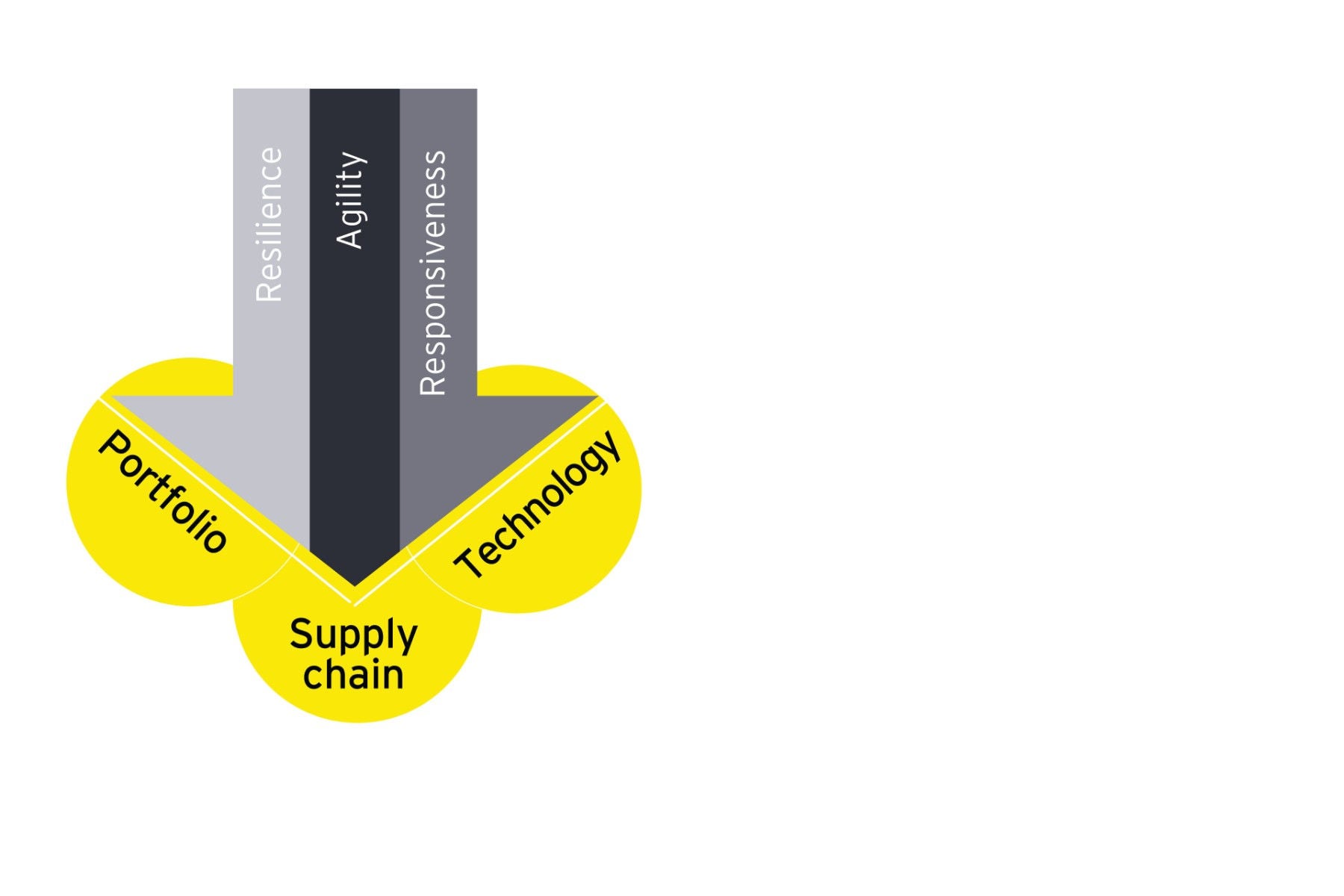EY refers to the global organization, and may refer to one or more, of the member firms of Ernst & Young Global Limited, each of which is a separate legal entity. Ernst & Young Global Limited, a UK company limited by guarantee, does not provide services to clients.

Many companies are delaying transformation of critical growth capabilities as they focus on challenges of today using yesterday’s capability.
In brief
- Consumer goods companies are over-reliant on their ability to go it alone. 90% do not pursue partnerships; ecosystems are essential to transforming at speed and scale.
- 71% of executives say that silos are a significant barrier to transformation efforts. As consumer goods firms adapt, the need to collaborate grows more urgent.
- Companies miss the sense of urgency around the consumer. Less than 1/4 of executives see consumer-centric models as critical to implement now to become future competitive.
Changing consumer expectations. Accelerating technological change. Increased industry convergence. Rising sustainability pressures. Antiquated systems. Talent and insular thinking. New market entrants. These were (and still are) just a few of the forces driving the need for transformation in the consumer goods sector. Industry leaders thought they had time to develop strategies around these headwinds. Now, the homework was due yesterday.
On top of this, a new set of unknown challenges are often breaking the limits of traditional consumer goods models. It’s in this environment that consumer goods leaders must find the capacity to keep up with existing pressures while simultaneously transforming for the rapid evolution of the industry. With the growing intensity of today’s inflation, supply chain and demand pressures, future strategy has been increasingly crowded out of the room. But the ability to thrive in this duality should now be considered “core competency” for consumer goods executives. This requires a new way of working, a re-invention, a systemic change.
EY commissioned MIT SMR Connections to conduct a survey of 188 US operations leaders from top consumer goods brands to explore how they are currently changing their operating models and if they will be sufficient to succeed in the future. The challenge isn’t a recognition of the need to change—98% of respondents believe that they must transform to ensure future success. The real issue is the lack of urgency, given the pace of change and outsized focus on the now.
This lack of urgency is compounded by a lack of focus on building key growth capabilities now to adapt to the future consumer. In an industry that hasn’t historically been ahead of the curve on rapid change, a future-fit operating model is not just important for consumer goods executives to thrive through the duality of disruption and growth. It is required.
Key barriers to change: Integration, Ecosystems and Consumer Centricity
Executives are confident in their ability to transform; 75% feel that they have the right capabilities in place. However, there are significant gaps in key areas that would more quickly enable companies to transform with the current pace of change.
Companies may be over reliant on their ability to go it alone.
Only 39% typically transform by acquiring capabilities, and 32% invest in existing ones; 90% do not pursue partnerships. The right strategy, skills and ways of working to pursue partnerships – or ecosystems – must be a key focus for the future consumer goods organization.
Companies lack collaboration within their own four walls.
Fifty-seven percent of US executives say that individual business units are autonomously responsible for operational strategy; they are 73% more likely to operate this way than their global counterparts. Despite this, executives agree that silos lead to stranded capacity. Seventy-one percent of respondents say that silos are a significant barrier to transformation efforts. As consumer goods firms move closer to both customers and consumers, the need for integration across replenishment, promotion, data and more grows.
Companies miss the sense of urgency around the consumer.
Less than one quarter of consumer goods executives see consumer-centric models as critical to implement now to become future-competitive. However, 82% see it as critical in the next five years. The EY Future Consumer Index clearly demonstrates the urgency of modeling operations based on consumer behavior as critical to stay competitive in the now, next and beyond.
A 3x3 strategy to accelerate the path to growth
In the current environment, there’s an extraordinary opportunity to build a dynamic, new consumer goods operating model to meet both today’s and tomorrow’s needs.
We’ve established that consumer goods operations executives recognize the opportunity. Nearly half (46%) believe that it’s critical for all business functions to operate differently in the near future. But they aren’t actioning it effectively. Why? Perhaps there’s some level of paralysis. The MIT study finds that roughly 50% of executives believe that all business functions are a priority for transformational success. Considering today’s capacity issues, when everything is a priority, nothing becomes a reality.
To derive value, consumer goods executives must rigorously drive resilience, agility and responsiveness deep into the culture and capability of three core areas of the business: supply chain, portfolio and technology and digital capabilities.

Addressing supply chain disruptions and digital capability
Re-evaluating portfolio strategy to seize market opportunities
Enabling the growth-minded operating model through technology
Now is the time for consumer goods companies to find the way
In the future, consumer goods companies will be adapting to new outcomes. The MIT study states that 74% of executives believe that their key performance indicators will be very different in just five years. This new market is rapidly taking shape, growing and evolving. Right now is the time to use the current disruptive crisis as permission to take those risks and get organizational buy-in.
To seize the moment at speed and scale, you need to use data-enabled insights to prioritize the right areas to transform and look for partners to enable you to execute more quickly and effectively. You need to find ways to infuse resilience, agility and responsiveness in your supply chain, portfolio and technology infrastructure. Those consumer goods companies that can build a strategy around these capabilities now will gain a valuable competitive edge to thrive in a future that is already here. The duality is the opportunity.
Summary
The consumer goods industry has entered a pivotal moment. Many companies are showing a lack of urgency to use the momentum of the moment as an opportunity. Those that can focus on implementing trusted data systems, automation and collaboration both internally and externally, in the right places, will thrive through disruption while freeing up the capacity and speed needed to meet the future consumer.
Related articles
The CFO’s perspective on balanced growth: a post-CAGNY view from Kellogg Company CFO Amit Banati
Amit Banati, CFO of Kellogg, offers his perspective on balanced growth and investing in emerging markets. Read more.
5 ways consumer products companies can let go to grow
Most consumer products companies built their operating models for efficiency. Can they grow faster by controlling less and trusting more? Learn how.
How EY can help
-
Discover how EY's supply chain team can help your business redefine its end-to-end supply chain and operations to support your enterprise objectives.
Read more -
EY-Parthenon professionals can help your business design and provide transformative strategies for sustainable growth. Learn more.
Read more -
Discover how EY's digital transformation teams can help your business evolve quickly to seize opportunities and mitigate risks. Find out more.
Read more





